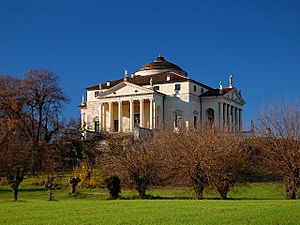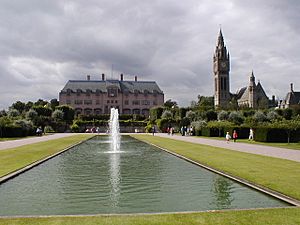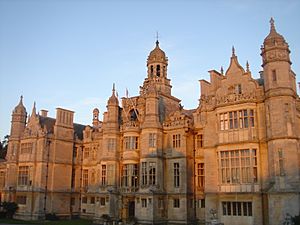Mansion facts for kids
A mansion is a very large and fancy house. In England, a "country house" is a common type of mansion found outside of cities.
Contents
History of Mansions
Long ago, in Ancient Rome, rich families lived in huge, luxurious homes. Some of these homes on the Palatine Hill in Rome were so grand that the word "palace" actually comes from the name of that hill! Very large mansions that are important to a country are often called palaces.
After the Roman Empire ended, people stopped building these open, unfortified villas. The oldest mansions still lived in today often started as strong castles in the Middle Ages. As society became safer, people didn't need such strong defenses. Over time, castles were changed or rebuilt to be more comfortable and beautiful, leading to the modern mansion.

In some parts of Asia, like Hong Kong and Japan, the word "mansion" can also mean a large building with many apartments. In modern Japan, a "manshon" (マンション) refers to a multi-unit apartment complex or condominium.
From the 1400s in Europe, new weapons and political changes meant that rich families no longer needed to live in fortified castles. Many castles were turned into mansions without defenses, or they were torn down and rebuilt in a more modern, open style. Because of marriages and inheritance laws, it was common for a noble person to own several country houses. They would travel between these homes throughout the year for social events and sports. Many also had a town mansion in the capital city, like London or Paris.
As the 1500s went on, new Renaissance styles spread across Europe. The old castle-like features changed. For example, the "great hall" where everyone ate together became less important. Owners wanted to live separately from their servants and eat in private rooms. Cooking smells and staff were moved to distant parts of the house. Owners lived in airy rooms above the ground floor, with privacy from servants who stayed in their own areas, like the ground floor or attics. This was a time of big social changes, as educated people valued new ideas.
These large houses were important for powerful families to stay connected. Social visits and parties were a key part of society, as shown in novels by Jane Austen. Important government discussions often happened in these informal settings. However, during times of revolution, like in France in 1789, many country mansions were destroyed by angry villagers. This showed a rejection of the old feudal system.
Before World War I, a mansion in England like Cliveden might have had 20 staff working inside and another 20 outside. In even larger mansions, like Chatsworth House, the numbers could be much higher. In Italy, the number of staff was often even greater. Whole families of servants might live in many rooms in the basements and attics. Most European mansions were also the center of huge land estates.
Mansions in the 1800s
The 1800s continued to see many mansions built in the United States and Europe. These were often built by people who had become rich themselves, and they were sometimes smaller than the older mansions of the European nobility. These new builders didn't just stick to the popular Gothic style. They also tried out new versions of older Renaissance and Tudor styles. The Breakers in Rhode Island is a great example of American Renaissance revival architecture.
In the 1800s, major streets in important cities, like Fifth Avenue in New York City, were lined with mansions. Many of these were designed by top architects of the time, often in European Gothic styles. They were built by families who were making their fortunes and rising in society. Sadly, almost all of these New York mansions have been torn down. This means New York doesn't have grand streets like those in Paris, London, or Rome, where many large mansions and palaces from that time still stand. Even grand country estates in the U.S. were sometimes demolished. For example, Whitemarsh Hall, a spectacular estate, was torn down in 1980 to make way for new housing developments.
In Salem, Massachusetts, there's an area with the largest collection of 17th and 18th-century buildings in the United States. This is the Chestnut Street District, centered around Chestnut Street, and it features grand Federal Style mansions designed by Samuel McIntire.
Samuel McIntire was born in Salem in 1757. He learned his skills from his father and from books. He started as a house builder and carpenter. Early in his career, his work caught the eye of a very important merchant named Elias Hasket Derby. Over 25 years, McIntire built or remodeled many homes for Derby and his family. He also worked on Derby's ships and even built smaller things if needed. Hamilton Hall, a National Historic Landmark at 9 Chestnut Street, was built by Samuel McIntire in 1805.
Derby's approval helped McIntire get many other jobs. He designed and built mansions for other wealthy shipowners in Salem. He also built a function hall (named for Alexander Hamilton) and a church for the town's rich class on elegant Chestnut Street. McIntire also designed the former Salem Court House.
After 1793, Samuel McIntire worked mainly in the Adamesque style, which was developed in Great Britain and brought to America by architect Charles Bulfinch. This delicate style focused on decorative elements and ornaments. It was perfect for McIntire, who had an amazing sense of design and was a skilled woodcarver. His homes built between 1793 and his death in 1811 often feature carved decorations like swags, rosettes, garlands, and his special wheat designs on wood surfaces.
Even in Europe, some 19th-century mansions were built to look like older houses. For example, the Château de Ferrières in France was inspired by Mentmore Towers, which itself was a copy of Wollaton Hall. Other mansions were built in new styles, like the Arts and Crafts style. The Breakers looks like an Italian Renaissance palace. Waddesdon Manor in England is a mix of different French châteaux. One of the most popular and copied styles for mansions was the Palladian style, especially in the 1700s. However, the Gothic style was probably the most popular design choice in the 1800s.
Mansions built during and after the 1800s were usually not supported by huge land estates like the earlier ones. These newer mansions were often built as weekend homes for business people who traveled to their city offices by the new railways. This made it easier for them to leave the city.
Mansions in Latin America

In Latin America, with its history of colonial rule, the large rural estate was a common feature. These estates, called Haciendas, Estancias, or Fazendas in Brazil, had a grand mansion as their main building.
These mansions often followed European architectural styles. Until the late 1800s, Portugal and Spain (the former colonial powers) were the main models for architecture and upper-class living. But towards the end of the 19th century, more powerful countries like France or England became the new influences.
In more developed and crowded countries like Mexico, feudal estates and their mansions were as grand as those in Europe. In less populated areas, like the Pampa of Argentina or Uruguay, where building materials like iron pillars, doors, and furniture had to be shipped from Europe, buildings were smaller. However, they still aimed to look grand, often featuring a morador (a type of tower or lookout).
In Venezuela, traditional Spanish mansions with a garden in the center are usually called "Quinta."
Modern Mansions

Mansions built in the 1900s and 2000s often have special rooms for hobbies and fun. Many have a conservatory (a glass room for plants) or a home theater. Some even have an infinity pool or a bowling alley. The types of special rooms change with the times. In the early 1900s, a mansion would always have a library or study. Today, a home theater is more common. Many modern mansions also have home automation systems, where you can control lights and temperature with a touch. Some even have a server room for all their technology.
A modern mansion isn't always just one house. Like Roman Emperor Nero's Domus Aurea, mansions can be a group of large houses together, forming a compound. The Kennedy Compound is an example of one family having several large houses on a single property.
Generally, whether a house is called a mansion depends on where it is. A 5,000 square foot house in Manhattan might be called a mansion, but a similar-sized house in a suburb of Atlanta probably wouldn't. Calling something a mansion means it's much grander and more luxurious than a typical home in that area. It also suggests high quality and is often linked to the homes of very wealthy people.
Images for kids
-
Gelbensande Manor, an 1885 mansion built for hunting, near Rostock, Germany.
-
Built in Renaissance Revival style, The Breakers in Newport, Rhode Island, is one of the best known 19th-century mansions in the United States.
See also
 In Spanish: Mansión para niños
In Spanish: Mansión para niños






